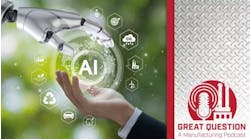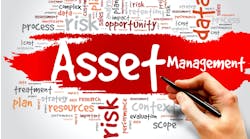The benefits—yes benefits!—of creating a sustainability-first culture
How do manufacturers create a “sustainability-first culture”? The IoT can help, says Corey Glickman, global head of sustainability and design consulting services with Infosys, who dives deeper into the topic in the Q&A below. Take a look…
Smart Industry: How do IoT tools enable a "sustainability first culture"?
Corey: The Internet of Things, and how it enables and drives a sustainability culture, is one of the big challenges for any organization. A first question to consider is How do I choose my metrics? Then that data needs to be collected and connected, which begs the next question What is the best way of collecting and verifying the data?’
IoT devices are one of the most accurate ways of doing this because it's all automated and impervious to human error. Put IoT in a building or environment and it will collect the data and eliminate the human component of collecting, understanding and translating it—whether it’s data from machines, air quality, temperatures or human elements. When that data is collected, it can then be extracted, visualized, or combined with AI and ML.
Further upstream, consider the global scope of the UN SDGs. The 2020 Sustainable Development Goals Report highlights timely, shared, high quality data as crucial step to mitigating the impact of COVID-19 on our global sustainable development goals (SDG) commitments. The report identifies key problems in three key areas—data gaps in assessing country progress, weak data production and the need for data innovation.
In effect, to stay on track, countries must accelerate data innovation. On an organizational or global scale, compared to other alternatives such as manual labor, IoT is simply the most efficient set of tools in terms of cost and accuracy for collecting the data related to sustainability. When combined with the cloud, it really makes a great enablement.
Smart Industry: What tools / techniques are we talking about here?
Corey: IoT tools enable sustainability because they can be tuned to whatever you need to measure. For environment, you can tune sensors to measure energy usage, air quality, and other environmental factors. While social somewhat overlaps with environmental, you can also measure factors such occupancy, population density and sanitation. For governance, sensors can be tuned to make sure whatever space is being monitored remains in compliance with regulations and helps capture data needed for reporting.
Getting it right, however, means focusing on a combination of factors, not just the IoT devices themselves. Obviously, there are choices in how you want to use IoT devices acting as sensors—and putting those sensors in the appropriate locations or frequency and working within regulatory compliance guidelines is really what's key. Then there’s the additional complexity of how people interact, and this is where you would find information, such as from social networks.
Once you have your data, there’s the question of choosing which data you want to share, and in what format. You can tune these devices, have them output into certain formats or into other systems in order to also look at a regulatory component like a scorecard or possibly as a real-time readout. But ultimately, IoT is the inexpensive way of doing more accurate work, which can then leverage the likes of artificial intelligence and machine learning to help you start looking for and addressing the anomalies.
Smart Industry: What verticals / industries are particularly positioned to capitalize on these opportunities?
Corey: You can reverse the question and ask which industries aren't positioned to capitalize on these opportunities! But let's start with the office, anything to do with energy, the energy industries in particular. Then there are industries with IoT devices partnering with edge computing in the field, including everything from oil rigs to oil stations, processing centers to manufacturing plants.
With manufacturing plants, you can put IoT devices on machinery and into rooms and environments that don’t need to be optimized for human occupancy. A human working in a digital farming environment (container growing, for example) would not be comfortable because of the light waves they're using. You can also put IoT devices in factories with robotics where you don't have to look at climate conditions but can still collect the data coming across.
Retail’s another big one, understanding everything from shipping logistics to what's happening on the shelves, or what's happening on the transports and having things tagged that way. Then there’s any kind of manufacturing, including IoT devices on machines, to help understand everything from vibration to efficiencies. Real estate and infrastructure are large opportunities too, even pharmaceuticals, where IoT helps us understand R&D units and logistics components.
One exception might be financial services. If you're talking about the buildings that people are in, you’re looking at another physical environment where IoT may be appropriate. If you're talking about where financial services are doing portfolio and risk management, however, we’re not there yet. But I can see a future where a bank or insurer would say that, in order for us to trust the data you're telling us about yourself, you should install IoT devices right within your environment. Being able to get the data directly off those devices would open whole new opportunities for financial institutions to consider.
Smart Industry: What is a ‘smart space’ and how is this approach being used in the COVID era?
Corey: Generally, a smart space is an area that, through the infusion of data, becomes much more valuable as an asset as it starts to do things.
A smart space really has three characteristics. One is asset and energy efficiency, which takes us back to the IoT component, where we’re enabling that smartness through IoT enablement. A second is concerned with user experience, where the buildings do a lot more for us. The third is to do with sustainability itself, given buildings are responsible for almost 40% of global greenhouse gas emissions.
The pandemic forced us to ask some fundamental questions. How do people check into a building? How do you make entry a touchless experience? How do we know how many occupants can be in a building? Then it got really scientific, to the level where part of our COVID solution was to work with sensors to understand micron levels and density of air molecules. This is where it gets pretty interesting—COVID molecules are actually two microns in size, whereas CO2 is 10 microns. One of the things we were able to do is use sensors to tie into air-control systems to create air pockets that prevent COVID from spreading.
So, the benefit of many IoT devices is that they address one of the key challenges of buildings: futureproofing. While the need of the hour is COVID, many of the solutions can be repurposed for other problems. Once we get past COVID, we can start transferring these sensors to doing other things, including making healthier buildings more conducive to productivity by optimizing oxygen levels.
While COVID was the focus, all solutions have to be sustained after COVID, with the goal now to create healthier buildings. The pandemic effectively accelerated innovation, shrinking years of progress into a matter of months. The good thing is that where COVID forced us to consider queuing for elevator systems, putting up digital signage, creating cleaner bathrooms or creating the right bubbles of air quality, we can use those same systems to work smarter and not have to rip-and-replace those components, but actually use them in meaningful ways to help create a great building experience.
Smart Industry: What most excites / encourages you about sustainability in the IoT era?
Corey: What most excites me is the potential to create the most accurate and cost-effective way of capturing data. The cost of IoT will continue to drop and, when devices are paired with the cloud, edge computing and 5G, IoT becomes the ultimate enabler.
Further downstream, as data becomes more accurate and automated, the financing of sustainability programs becomes much more achievable. There really is no excuse for companies to not be pursuing smart spaces right now.



